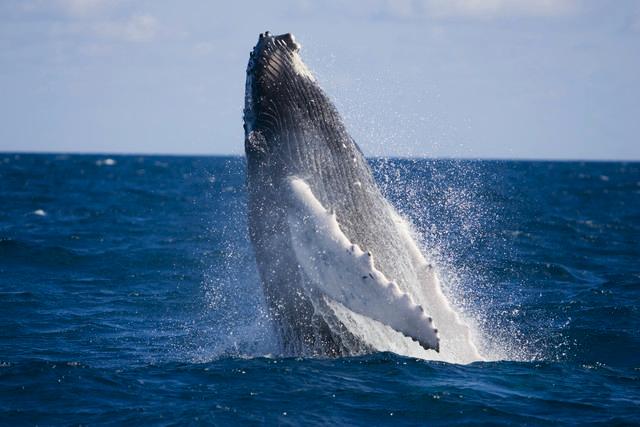Summer Wildlife Series: Whales

Alaska may be well known for its bears, moose and other mighty land mammals, but with the largest amount of coastline of any other state, you can bet the aquatic life is equally impressive. Whether you’re planning a cruise or simply driving down the scenic Seward Highway, a trip to Alaska isn’t quite complete without the iconic sight of a breaching whale. We’ve collected some helpful info and viewing tips on a few of Alaska’s most popular whale species – and since summer months are the peak viewing time for most of them, we’re confident you’ll be able to check a few off your list in no time!
Humpback Whale
Humpback whales can be identified by the hump on their backs right in front of the dorsal fin. Their coloring is nearly all black besides their white throats and they’re often covered (literally) in tons of barnacles. Whale watchers will usually only see one or two humpbacks at a time since they tend to travel and feed alone. Humpback whales summer in the North Pacific region; June and July are especially popular months to view them off the coast of Kodiak Island, Alaska, or out in Kachemak Bay near Homer, Alaska. They retreat to much warmer climates as Alaska’s summer draws to a close.
Other hot spots: Southeast Alaska, Prince William Sound
Gray Whale
This giant whale is, not unexpectedly, gray in color and reaches lengths of up to 40 feet. Gray whales are curious by nature, which makes for great whale watching as they aren’t afraid to swim up close to boats. Like the humpbacks, they spend their winters in warmer climates and summer in the North Pacific region. The annual gray whale migration north to Alaska in April and May is a popular viewing time in Southeast Alaska and Seward’s Resurrection Bay.
Other hot spots: Ketchikan, Sitka and Kodiak
Orca Whale
The killer whale, or the orca, is in fact not a whale at all but member of the dolphin family. Nonetheless it’s a must-see member of Alaska’s aquatic community. With its striking black-and-white coloring, the orca is one of the most recognizable inhabitants of the sea. Killer whales can grow to be 30 feet long, swim 30 miles per hour and weigh over 11,000 pounds. Aptly named, they are one of the ocean’s fiercest predators. They live in pods of up to 40 members, so if you see one orca you can expect to see more. Look for them near Seward, Alaska, from early May through June, with viewing chances well into September.
Other hot spots: Prince William Sound, Aleutian Islands, Southeast Alaska
Beluga Whale
The beluga’s name comes from the Russian word for white, and these endangered whales are a rare and special sight to see. They generally stay away from areas heavily populated by humans, but often come to hunt in shallow coastal waters – which make for some great viewing opportunities. A fish-eating toothed whale with short flippers and no dorsal fin, belugas grow to be around 12 to 14 feet in length or more, and weigh a few thousand pounds. These highly social whales travel in large pods that are mesmerizing to watch swim by, especially in spring or fall months along Southcentral Alaska’s Turnagain Arm.
Other hot spots: The Yukon’s north coast, Cook Inlet
Other Whales
Other whales in Alaska’s waters include sperm whales, minke whales and bowhead whales. There are whales to be seen in nearly every coastal spot in Alaska and Canada, so don’t forget the binoculars and extra camera batteries!
Back to Blog